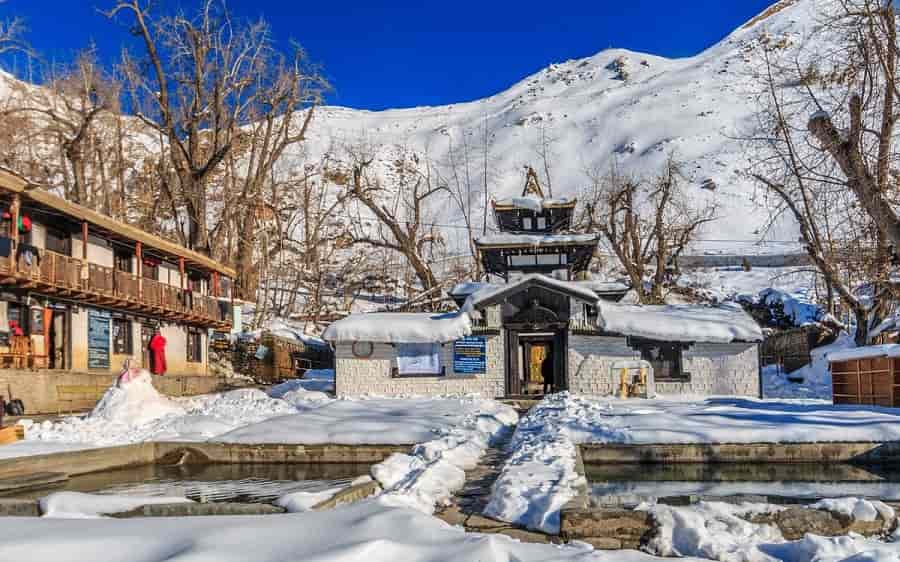Perched at an altitude of 3,710 meters in the Annapurna region, Muktinath Temple holds a unique place in the hearts of Hindus and Buddhists. The name “Muktinath” translates to “Place of Liberation,” emphasizing its role in liberating individuals from the cycle of birth and death. The serene environment and breathtaking surroundings contribute to the temple’s aura of spirituality and tranquility.

Deity of Muktinath Temple
The temple is dedicated to Lord Muktinath, a revered deity believed to be an embodiment of Lord Vishnu. Lord Muktinath’s image is distinct and captivating, with a human-like face and a boar-like body, symbolizing Lord Vishnu’s Varaha incarnation. This representation signifies the divine balance between preservation and transformation, reflecting the cosmic order and offering devotees a visual representation of the divine cosmic cycle.
Location and Accessibility
Muktinath Temple is situated in the Mustang district of Nepal, surrounded by awe-inspiring natural beauty. The journey to the temple is an adventure in itself, with options ranging from a scenic trek to a helicopter ride, each providing a unique perspective of the region’s terrain, diverse flora, and charming villages. The temple’s remote location adds to its allure, allowing visitors to disconnect from the outside world and immerse themselves in spirituality.
Architectural Marvels
The architecture of Muktinath Temple is a blend of ancient and contemporary styles, reflecting the evolving cultural influences over the centuries. The pagoda-style structure is adorned with intricate wood carvings, adding to its aesthetic charm. The 108 water spouts within the temple complex are not only a visual spectacle but also hold immense religious significance. Bathing in these holy waters is believed to cleanse the body and soul, purifying devotees of their sins.
Religious Significance
Muktinath, a sacred site situated in the Mustang district of Nepal, holds immense religious significance for both Hindus and Buddhists. The name “Muktinath” is derived from two Sanskrit words: “mukti,” meaning liberation or salvation, and “nath,” meaning lord or deity. As a result, Muktinath is often referred to as the “Lord of Liberation,” symbolizing its spiritual importance.
Hindu Beliefs
For Hindus, Muktinath is one of the 108 Divya Desams, holy abodes of Lord Vishnu. It is believed that Lord Vishnu took the form of Lord Sri Muktinath Narayana in order to provide salvation to his devotees. The central deity of Muktinath is a stone idol of Vishnu in the form of Narayana, with a golden crown and a mace in one hand. The deity is bathed with water from 108 stone spouts, symbolizing the purifying nature of the pilgrimage.
Buddhist Significanc
Buddhists consider Muktinath an important pilgrimage site as well. It is one of the 24 Tantric places in the Himalayan region, and Buddhists associate it with the deity Avalokiteshvara (Chenrezig in Tibetan), who embodies compassion. The site also holds importance for followers of Tibetan Buddhism, and there are several monasteries nearby.
Shared Importance
Interestingly, Muktinath exemplifies the harmonious coexistence of Hinduism and Buddhism. In close proximity to the Hindu temple, there is a Buddhist monastery where both Hindu and Buddhist devotees offer prayers. The natural elements at Muktinath, including the surrounding mountains and the nearby Kali Gandaki river, are also considered sacred and are believed to have healing properties.
Pilgrimage and Rituals
Devotees from both religions undertake arduous journeys to reach Muktinath, often walking for days through challenging terrain. It is believed that taking a holy bath in the 108 water spouts brings spiritual purification and grants liberation from the cycle of birth and death. Pilgrims also circumambulate the temple, offer prayers, light butter lamps, and make offerings.
Festivals Celebrated at Muktinath Temple
Muktinath Temple comes alive during festivals, with vibrant celebrations that unite people from diverse backgrounds. The Yartung Horse Festival, celebrated by the local Thakali community, showcases traditional horse races and cultural performances. Additionally, the Janai Purnima festival witnesses the tying of sacred threads on the wrists of devotees as a symbol of protection and blessings.
FAQs
Can non-Hindus visit Muktinath Temple?
Yes, the temple welcomes visitors of all faiths to experience its spiritual ambiance and natural splendor.
Is there accommodation available near the temple?
Yes, there are lodges and guesthouses available in the vicinity to accommodate pilgrims and tourists.
What is the best time to visit Muktinath Temple?
The ideal time to visit is during the spring (March to May) and autumn (September to November) seasons when the weather is pleasant and the skies are clear.
Are photography and videography allowed inside the temple?
Yes, photography and videography are allowed in most areas of the temple complex.
What should I wear while visiting the temple?
Modest clothing is recommended as a sign of respect for the sacredness of the site.
- Suggested Tour: Muktinath Yatra Tour Package

 Call
Call WhatsApp
WhatsApp Enquiry
Enquiry